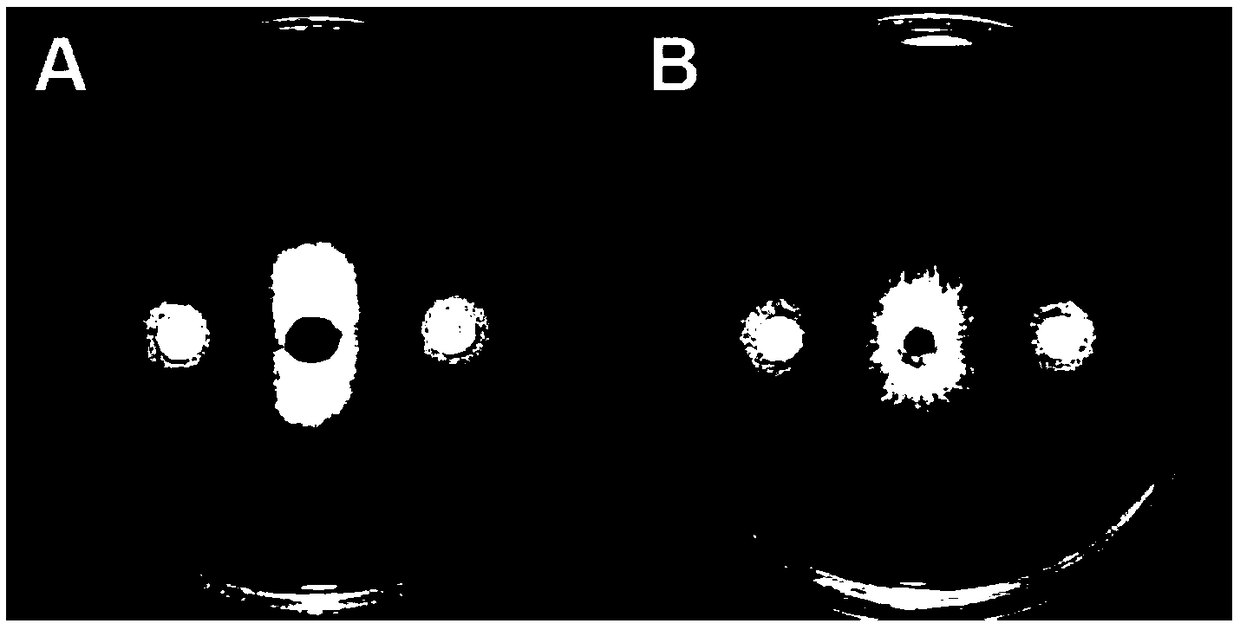Radix curcumae endophytic bacteria strain ZJU-C612-2 and application thereof
A technology of use and germs, applied in the field of endophytic bacteria in curcuma, which can solve the problems of under-exploitation of important resources
- Summary
- Abstract
- Description
- Claims
- Application Information
AI Technical Summary
Problems solved by technology
Method used
Image
Examples
Embodiment 1
[0024] Embodiment 1, the screening of bacterial strain ZJU-C612-2
[0025] Healthy Wenyujin tubers are collected from Yunhe County, Lishui City, Zhejiang Province. The isolation of endophytic bacteria adopts the conventional tissue separation method (refer to "A Method for Separating Endophytic Bacteria in Plants" already published in CN103122331A), and a total of 25 strains of endophytic bacteria were isolated. .
[0026] The screening of antagonistic strains adopts the plate confrontation method, and the specific steps are:
[0027] (1) Activate the endophytic bacteria on the LB solid plate, select a ring of single colonies and inoculate them into 4ml of LB liquid medium, and place them in a 200r / min shaking incubator at 37°C for 24h as a strain, with 1% (Volume %) Inoculum amount Inoculate the endophytic bacteria into a new LB liquid medium, culture at 37° C. with shaking at 200 r / min for 24 hours, and obtain endophytic bacteria fermentation liquid for later use.
[0028]...
Embodiment 2
[0031] Embodiment 2, identification of bacterial strain ZJU-C612-2
[0032] The 16S rDNA gene sequence of strain ZJU-C612-2 was amplified and sequenced with universal primers F27 and R1522, and a sequence with a size of 1487bp was obtained. The sequence was uploaded to GenBank to obtain the gene accession number: KY078349.1. Blast comparison analysis was performed on the sequence on the NCBI website, and the results showed that the similarity between it and Bacillus Velez (CP023414.1), Bacillus amyloliquefaciens (KT961125.1) and Bacillus subtilis (HQ711983.1) was average. 99%.
[0033] After the bacterial strain ZJU-C612-2 was cultured on the LB plate for 24 hours, the single colony formed was similar to a circle, with irregular edges, bulges, wrinkled surfaces, opaque, and the colonies were white ( figure 2A). The strain B-11 observed under the transmission electron microscope was rod-shaped or cylindrical, with multiple flagella around it, and the size was (0.94-1.18) μm×...
Embodiment 3
[0038] Embodiment 3, bacterial strain ZJU-C612-2 produce the mensuration of bacteriostatic substance
[0039] 1. Determination of Protease Production Ability
[0040] Spot the strain ZJU-C612-2 on the protease detection plate (A: Dissolve 8g of skimmed milk powder in 300mL of distilled water, sterilize at 115°C for 10min, B: add 8g of agar with distilled water to 300mL, sterilize at 121°C for 20min, A and B respectively sterilized and then mixed), cultured in the dark at 30°C for 2 days, and it was found that the edge of the strain ZJU-C612-2 produced an obvious transparent circle ( image 3 A), showing that strain ZJU-C612-2 can produce protease.
[0041] 2. Determination of the ability to produce chitinase
[0042] Bacterial strain ZJU-C612-2 was spot-inoculated on the culture medium (ammonium dihydrogen phosphate 1.0g, potassium chloride 0.2g, magnesium sulfate hydrate 0.2g, w=1% colloidal chitin) with colloidal chitin as the only carbon source. Butin 100mL, agar 20g, di...
PUM
 Login to View More
Login to View More Abstract
Description
Claims
Application Information
 Login to View More
Login to View More - R&D
- Intellectual Property
- Life Sciences
- Materials
- Tech Scout
- Unparalleled Data Quality
- Higher Quality Content
- 60% Fewer Hallucinations
Browse by: Latest US Patents, China's latest patents, Technical Efficacy Thesaurus, Application Domain, Technology Topic, Popular Technical Reports.
© 2025 PatSnap. All rights reserved.Legal|Privacy policy|Modern Slavery Act Transparency Statement|Sitemap|About US| Contact US: help@patsnap.com



